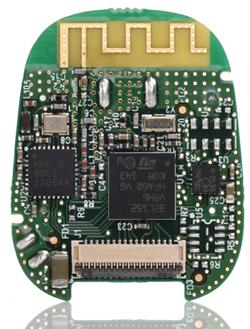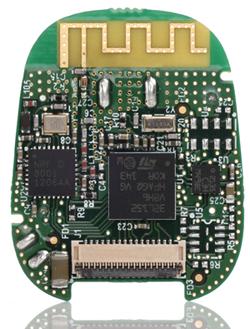Teardown: Fitbit Zip Packs Lots of Functionality Into Small, Water-Tight Package
January 4, 2013

It was with a fair amount of disappointment that I had to perform a teardown on the Fitbit Zip. Not that I don't like taking things apart and analyzing their design. Quite the contrary; it's one of the most fun tasks I get to perform as part of my job. The disappointment came because I got pretty attached to the device (figuratively). I'm a semi-regular runner, and the Zip helped me get the most out of my workouts. And taking it apart ended that relationship. If you're familiar with my teardown articles, I only use one tool -- a hammer. So putting the device back together was a non-issue.
You put the Fitbit Zip somewhere on your body, such as in your pocket, your sock, etc., and you keep it there all day, whether you're doing an actual workout, walking through the mall, or doing just about anything that requires you to move. The device tracks your steps, distance, and calories burned, and syncs those stats to your computer and/or smartphone. In doing so, it keeps a record of how much more you do each day. The Zip encourages you to set and exceed goals. Being the competitive person that I am, it really worked.
But duty called, and it was time to end my relationship with the Zip. Taking it apart revealed frankly, not much. I guess that's the beauty of the design, its simplicity from a hardware perspective. It contains a display, a processor, a communications IC, a bunch of sensors, and the usual passives and logic. The complex functionality combined with the limited number of components results in a fairly impressive design.

I reached out to Fitbit's CEO, James Park, who, as it turns out, was quite hands-on with the design of this device. Since this is the third (or fourth, depending on how you count) generation, the company had a lot of experience developing wearable wireless devices.
The original Fitbit device debuted in 2009. The Ultra came out in 2011, and was a revision of the first product. Then there's the Fitbit One and the Zip. A key part of the revisions was a continual refinement of the power management circuitry. Another component that shows up in the One that makes it a real differentiator is an altimeter, a sensor that lets the device measure the number of floors the user has climbed.
This Zip design was about two years in the making. First, there were a few months of white boarding and industrial design, etc. The remaining time was pretty straightforward engineering.
There are various wireless media that could have been deployed in the Zip. They chose Bluetooth low energy, specifically the nRF8001 from Nordic Semiconductor. The part integrates a fully compliant Bluetooth v4.0 low energy radio, link layer, and host stack, and features a simple serial interface that supports a wide range of external microprocessors. In the Zip, it connects to an STMicroelectronics Cortex M3 processor.
With peak currents as low as 12.5 mA and average currents down to 9 mA (for a 1-second connection interval), the nRF8001 enables a battery life ranging from months to years from a single coin cell. It also includes an analog-to-digital converter for battery-level monitoring, and a low-tolerance 32-kHz RC oscillator that eliminates the need for an external 32-kHz crystal. That's another example of how the Fitbit engineers minimized the components/size of the end device. The IC fits in a 5mm x 5mm QFN package.
Because there was no way to tell how and where the user would "wear" the Zip, lots of scenario testing had to be done. According to Park, "We ran tests with the device being worn in all the places that it was likely to be worn and took measurements in all those spots. Obviously the characteristics of the radio and its performance will differ when it's close to your body as opposed to just lying on a table."
Some of the design goals could have been accomplished using a non-standard radio, and may have even been a cheaper alternative. But one of the original design goals was to have the device sync with standard smartphones. Hence, the move to Bluetooth. Fitbit evaluated some of the popular Bluetooth offerings from vendors like Nordic, CSR, Broadcom, and Texas Instruments. Each came with various tradeoffs, including, size, power, and cost.
About the Author(s)
You May Also Like



